CSUTOMER SERVICE TRAINING
On July 7th, 2025, a comprehensive customer service training was held at the House of Comfort Restaurant in Limbe, Cameroon. Organized by am Speed Up Sales consultancy firm specializing in Marketing & Sales with Customer experience, the training aimed to upgrade service delivery standards, foster a customer-first culture, and equip staff with practical, consistent methods for handling guests, improving satisfaction, and increasing customer retention.
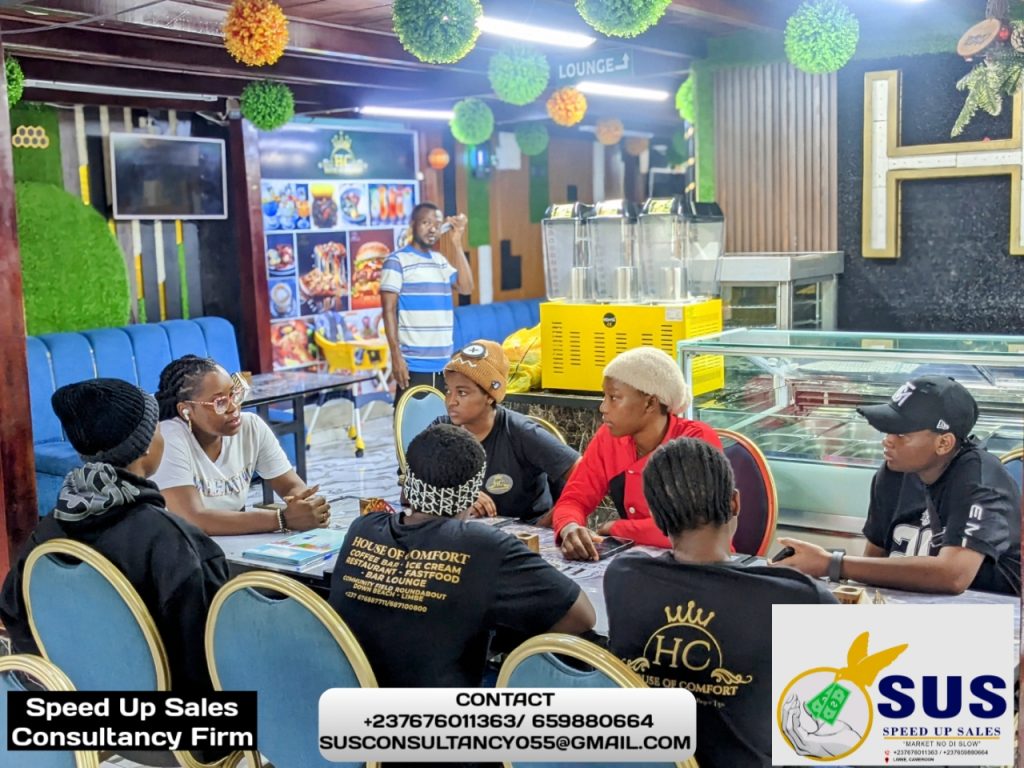
House of Comfort, a fast-growing mid-range restaurant known for its welcoming ambiance and local-meets-modern menu, had observed gaps in staff service consistency and communication flow during peak hours. With increasing competition in the hospitality space, the restaurant’s leadership recognized the need to invest in human capital and elevate the customer experience as a strategic priority. This report presents a detailed breakdown of the training content, structure, participant feedback, key outcomes, and recommendations to sustain long-term service excellence.
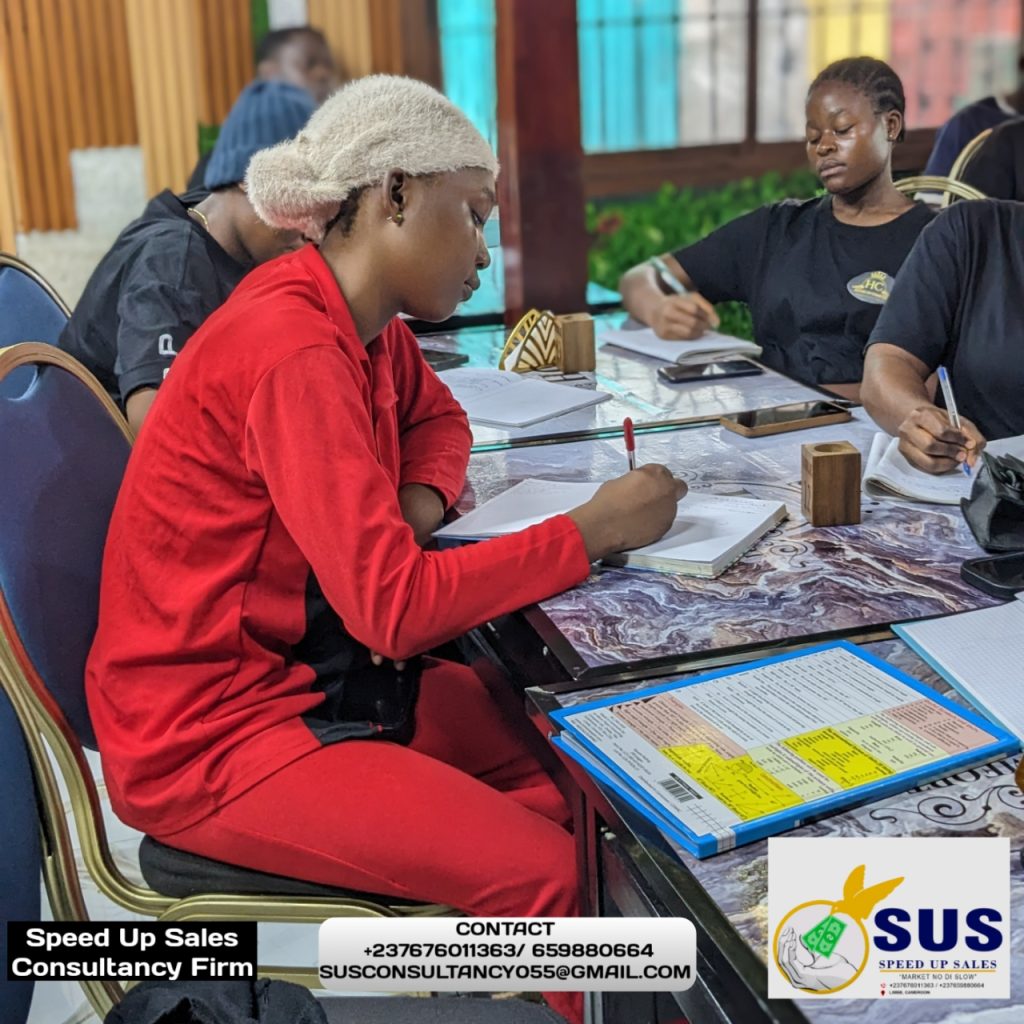
- Training Objectives
The training’s primary objectives were:
1. Build a Unified Service Mindset: Ensure all employees—from front-of-house to kitchen support—understand their role in customer satisfaction.
2. Develop Core Service Skills: Equip participants with effective communication tools, problem-solving strategies, and proactive customer interaction techniques.
3. Improve Consistency Across Shifts: Introduce service standards and checklists to reduce variation in guest experiences.
4. Boost Employee Morale: Motivate staff by showing that management values their development and contributions.
⸻
- Training Context and Motivation
In the months leading up to the training, House of Comfort had seen rising foot traffic—particularly from middle-income families and professionals—but also experienced several customer complaints. These included:
• Slow table service during busy hours
• Inconsistent greetings and order-taking routines
• Lack of knowledge on dietary requests and specials
• Poor complaint handling in isolated cases
Restaurant management sought a hands-on, practical training session that would not only address these concerns but also instill a lasting culture of service excellence across all touchpoints.
⸻
- Participant Demographics
A total of 28 staff members participated in the training, drawn from various departments:
• Waitstaff (12) – Including both full-time and part-time servers
• Cashiers (3)
• Hostesses/Front Desk (4)
• Kitchen Supervisors (2)
• Bar Staff (2)
• Delivery and Takeaway Staff (3)
• Floor Manager & Assistant Manager (2)
Participants had varying levels of experience, from new hires to employees with over 5 years of service. This range created a dynamic and insightful training environment, where peer-to-peer learning was encouraged.
- Training Structure and Approach
The training ran from 8:30 AM to 4:30 PM and followed a structured yet interactive format. It combined short lectures, visual case studies, role-playing, team-building activities, and scenario-based workshops.
Core training methodologies included:
• Interactive Presentations to introduce concepts and service models
• Group Discussions to reflect on customer pain points and experiences
• Role-Playing Activities to practice greetings, upselling, and complaint resolution
• Live Demonstrations of order taking, serving, and handling feedback
• Worksheets and Reflection Exercises for individual takeaways
• Pre- and Post-Session Surveys to assess knowledge gained
Training materials provided included a custom-made “Service Playbook,” containing scripts, standard operating procedures (SOPs), response templates, and service etiquette guides tailored to House of Comfort.
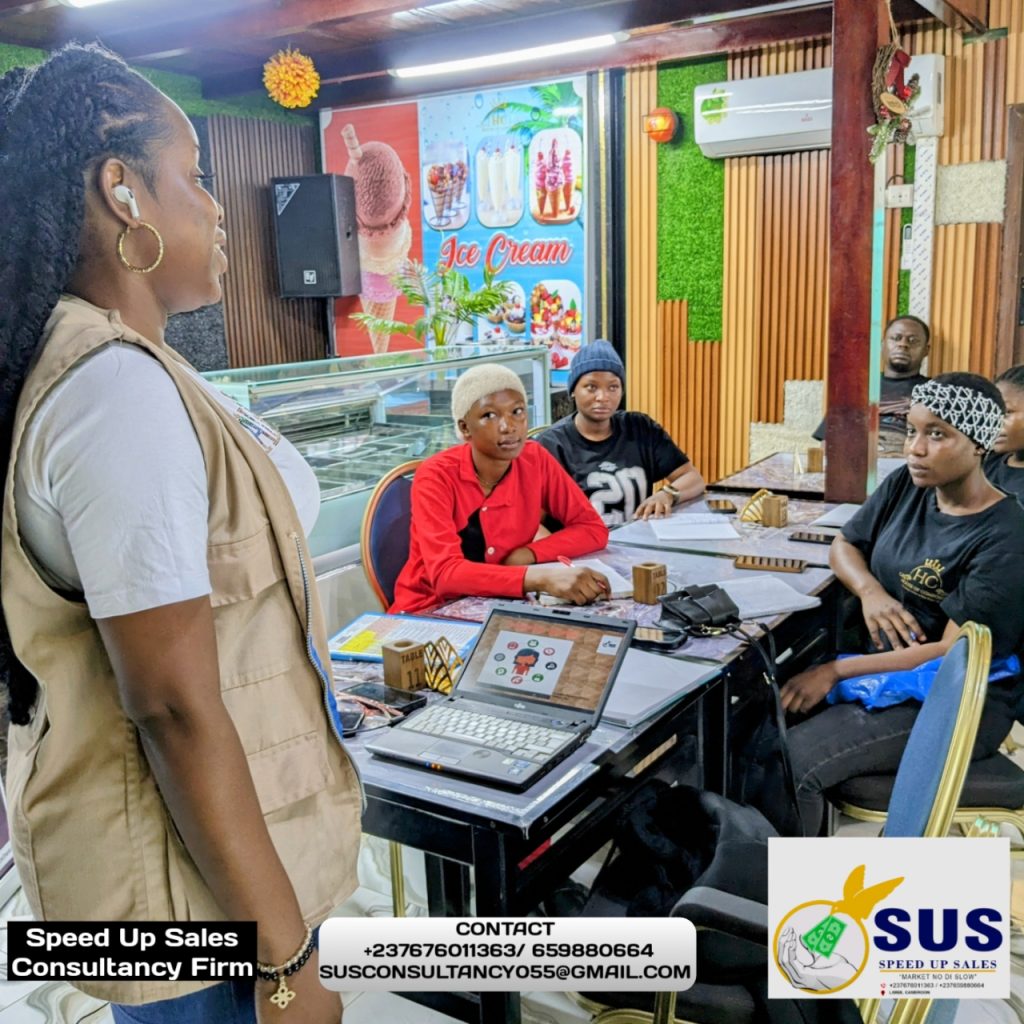
- Key Training Topics and Insights
6.1. The Meaning of Excellent Service
Participants explored what separates a “transactional experience” from a “memorable dining moment.” A model was introduced—The 3Rs of Service:
• Respect: Acknowledging all guests equally, regardless of appearance or background.
• Responsiveness: Meeting needs quickly and attentively.
• Reliability: Following through on promises (e.g., delivering drinks within 5 minutes).
Team members identified personal examples of when they had provided or received great service.
6.2. First Impressions & Hospitality Etiquette
Training emphasized how guests form opinions within the first 30 seconds. Staff learned:
• To greet every guest warmly within 10 seconds of arrival
• To smile genuinely, use open body language, and establish eye contact
• Dress code reinforcement, especially during lunch rush
• Appropriate greetings for solo diners, couples, and families
Role-plays included welcoming walk-ins, managing waiting queues, and delivering menus with charm.
6.3. Communication Skills
Focus was placed on both verbal and non-verbal communication:
• Clear speech, polite tone, avoiding slang or jargon
• Body posture, gestures, and facial expressions
• Active listening: paraphrasing, confirming orders, and using the guest’s name where appropriate
• Showing empathy during complaints and delays
Group exercises simulated real interactions between servers and guests, with feedback from facilitators.
6.4. Complaint Handling & Difficult Guests
Participants were introduced to the LEARN model:
• Listen actively
• Empathize genuinely
• Apologize sincerely
• Resolve effectively
• Notify management for documentation or escalation
Realistic scenarios were practiced, including cold meals, billing errors, and long wait times. Staff practiced staying calm under pressure, using positive language, and following through with service recovery actions.
6.5. Upselling & Customer Retention
Using techniques such as suggestive selling and bundling, participants learned how to increase average spend without being pushy. They practiced offering:
• Appetizers while guests review the menu
• Dessert specials when guests near the end of their meal
• Drinks and wine pairings during order taking
Each participant crafted and delivered three upselling scripts, which were reviewed by peers for authenticity and confidence.
6.6. Internal Communication and Team Synergy
Breakdowns in service often stem from poor internal coordination. The team learned:
• Best practices for communicating kitchen delays
• Standardized language for relaying table needs
• Using hand signals and walkie-talkies efficiently (for large group bookings)
• Respecting each other’s roles and responsibilities
A role-play exercise involving a high-volume lunch shift helped staff practice clear, timely communication and support.
6.7. Embedding Service Culture
This closing session focused on how to keep momentum beyond the training. Discussions included:
• Setting team service goals
• Creating a “Wall of Appreciation” for positive feedback
• Weekly 15-minute “Service Circles” to share guest stories
• Recognizing top performers monthly with rewards
Staff created individual service pledges (e.g., “I will smile at every guest before they sit”) and posted them on a common board.
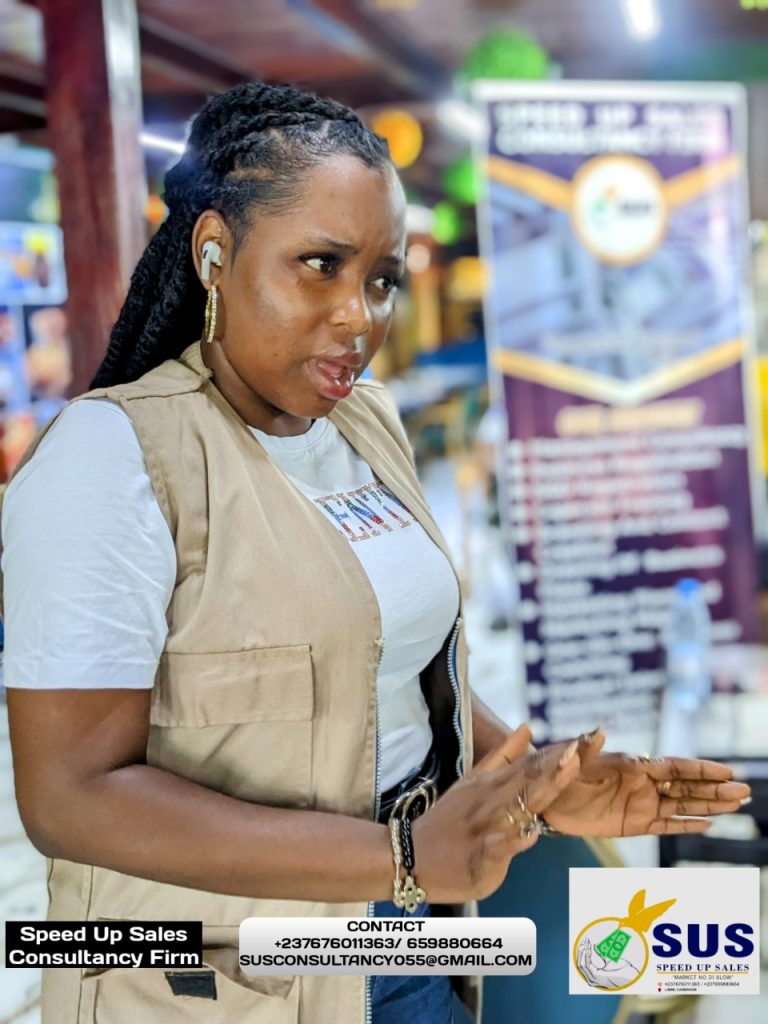
- Key Training Topics and Insights
6.1. The Meaning of Excellent Service
Participants explored what separates a “transactional experience” from a “memorable dining moment.” A model was introduced—The 3Rs of Service:
• Respect: Acknowledging all guests equally, regardless of appearance or background.
• Responsiveness: Meeting needs quickly and attentively.
• Reliability: Following through on promises (e.g., delivering drinks within 5 minutes).
Team members identified personal examples of when they had provided or received great service.
6.2. First Impressions & Hospitality Etiquette
Training emphasized how guests form opinions within the first 30 seconds. Staff learned:
• To greet every guest warmly within 10 seconds of arrival
• To smile genuinely, use open body language, and establish eye contact
• Dress code reinforcement, especially during lunch rush
• Appropriate greetings for solo diners, couples, and families
Role-plays included welcoming walk-ins, managing waiting queues, and delivering menus with charm.
6.3. Communication Skills
Focus was placed on both verbal and non-verbal communication:
• Clear speech, polite tone, avoiding slang or jargon
• Body posture, gestures, and facial expressions
• Active listening: paraphrasing, confirming orders, and using the guest’s name where appropriate
• Showing empathy during complaints and delays
Group exercises simulated real interactions between servers and guests, with feedback from facilitators.
6.4. Complaint Handling & Difficult Guests
Participants were introduced to the LEARN model:
• Listen actively
• Empathize genuinely
• Apologize sincerely
• Resolve effectively
• Notify management for documentation or escalation
Realistic scenarios were practiced, including cold meals, billing errors, and long wait times. Staff practiced staying calm under pressure, using positive language, and following through with service recovery actions.
6.5. Upselling & Customer Retention
Using techniques such as suggestive selling and bundling, participants learned how to increase average spend without being pushy. They practiced offering:
• Appetizers while guests review the menu
• Dessert specials when guests near the end of their meal
• Drinks and wine pairings during order taking
Each participant crafted and delivered three upselling scripts, which were reviewed by peers for authenticity and confidence.
6.6. Internal Communication and Team Synergy
Breakdowns in service often stem from poor internal coordination. The team learned:
• Best practices for communicating kitchen delays
• Standardized language for relaying table needs
• Using hand signals and walkie-talkies efficiently (for large group bookings)
• Respecting each other’s roles and responsibilities
A role-play exercise involving a high-volume lunch shift helped staff practice clear, timely communication and support.
6.7. Embedding Service Culture
This closing session focused on how to keep momentum beyond the training. Discussions included:
• Setting team service goals
• Creating a “Wall of Appreciation” for positive feedback
• Weekly 15-minute “Service Circles” to share guest stories
• Recognizing top performers monthly with rewards
Staff created individual service pledges (e.g., “I will smile at every guest before they sit”) and posted them on a common board.
⸻
- Results and Immediate Impact
The impact of the training was evident almost immediately:
Post-Training Survey Results (n=28):
• 100% found the training “useful” or “very useful”
• 92% said they now feel confident handling complaints
• 89% expressed improved confidence with upselling
• 85% committed to using greeting scripts and empathy statements daily
Manager Observations (1 Week Post-Training):
• Guests were greeted faster and with more enthusiasm
• Staff communicated more clearly during high-pressure hours
• Sales of appetizers and drinks rose by 15% compared to previous week
• No major guest complaints were recorded in the first seven days post-training
A mystery guest, deployed two days after the training, rated their experience 9.5/10 and complimented the staff’s “genuine warmth and professionalism.”
⸻
- Challenges Encountered
Despite the success, some challenges arose:
• Resistance from Senior Staff: Some long-serving team members were hesitant at first, believing they “already knew it all.” This was overcome by involving them in co-facilitating role-plays and praising their mentorship.
• Time Constraints: The busy lunch rush meant that breaks had to be adjusted and some modules condensed.
• Language Barriers: A few junior staff members preferred explanations in Pidgin or French. In response, the facilitator adopted simple, bilingual phrasing.
⸻
- Recommendations for Sustained Impact
- Monthly Refresher Micro-Trainings: Short 45-minute sessions focused on key service themes.
- Daily Pre-Shift Huddles: A 5-minute ritual to share focus points, such as “smile and offer water first.”
- Internal Service Champions: Assign a rotating “service ambassador” weekly to observe peers and share positive feedback.
- Customer Feedback Cards: Introduce small cards for guests to rate their service and leave suggestions.
- Upselling Contest: A friendly monthly competition with rewards for those who upsell the most successfully and ethically.
- Team Accountability Chart: A visual dashboard tracking complaints, compliments, upsell ratios, and goal progress.
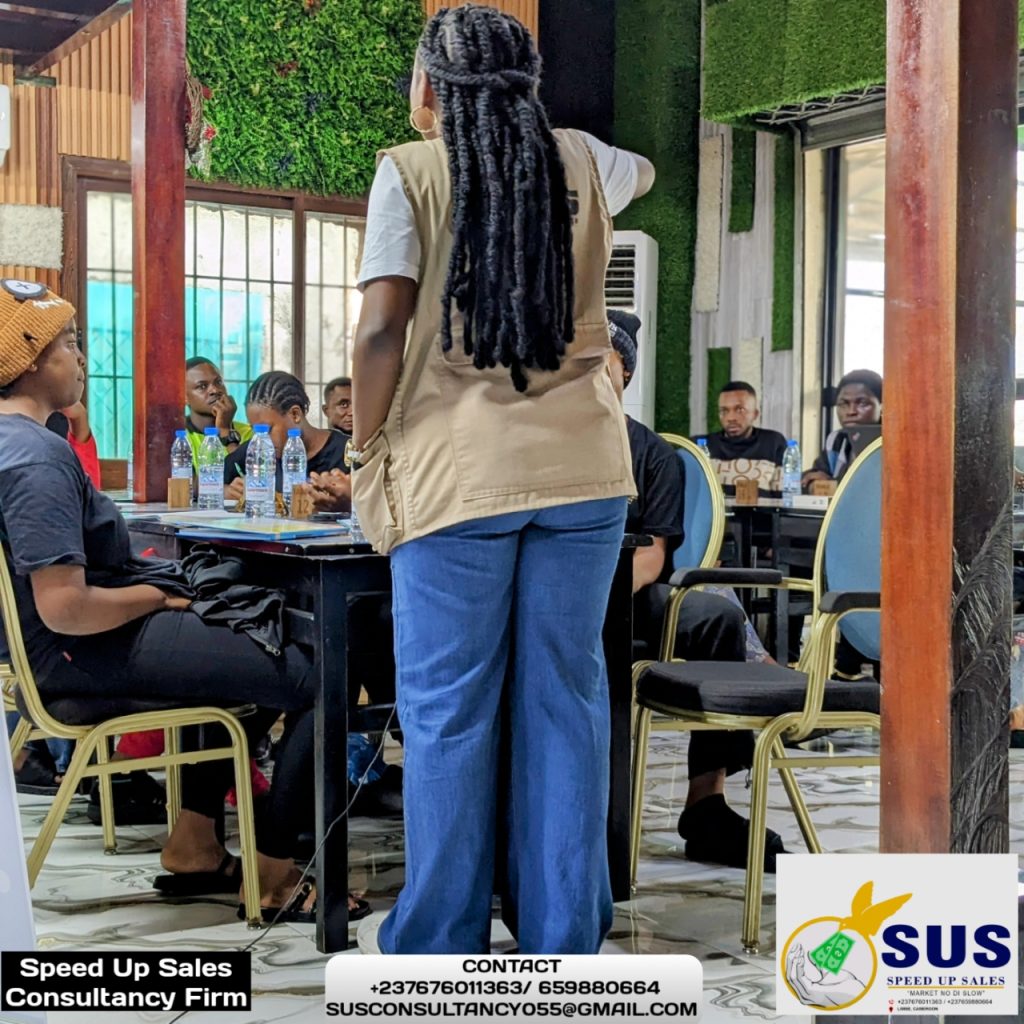
- Conclusion
The Customer Service Training at House of Comfort Restaurant proved to be not only timely but transformative. Participants left feeling empowered, more connected as a team, and better equipped to turn first-time visitors into loyal, returning customers.
As the hospitality industry continues to evolve, service remains a differentiator. Through this training, House of Comfort has taken a major step forward in redefining what it means to serve—not just food—but an experience that keeps guests coming back.
With continued reinforcement, follow-up coaching, and recognition programs, the restaurant is now well-positioned to lead in service excellence across Limbe and beyond.
Prepared by Speed Up Sales Consultancy Firm, on July 7th 2025 – Limbe, Cameroon
For further support, follow-up training, or customer experience strategy development, please contact susconsultancy055@gmail.com or +237 6 76 01 13 63 / +237 6 59 88 06 64.
